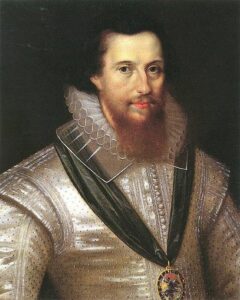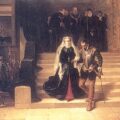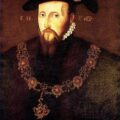
At just before 8am on the 25th February 1601, Essex was brought out of the Tower of London and walked to the scaffold. He was wearing a black velvet gown, black satin doublet and breeches, and a black hat, which he took off as he climbed up onto the scaffold so that he could bow to the people gathered. He then made a speech acknowledging “with thankfulness to God, that he was justly spewed out of the realm” and said:-
“My sins are more in number than the hairs on my head. I have bestowed my youth in wantonness, lust and uncleanness; I have been puffed up with pride, vanity and love of this wicked world’s pleasures. For all which, I humbly beseech my Saviour Christ to be a mediator to the eternal Majesty for my pardon, especially for this my last sin, this great, this bloody, this crying, this infectious sin, whereby so many for love of me have been drawn to offend God, to offend their sovereign, to offend the world. I beseech God to forgive it me – most wretched of all.”
After praying that God would preserve the Queen and asking the crowd to join him in prayer, he begged God to forgive his enemies. He then removed his gown and ruff and knelt at the block, looking up at the sky and saying the Lord’s Prayer. After forgiving the executioner, who knelt in front of him, Essex repeated the Creed and then took off his doublet, as it was covering his neck, to display a waistcoat of scarlet, the colour of martyrs. He laid himself on the block, stretched out his arms and prayed, “Lord be merciful to Thy prostrate servant… Lord, into Thy hands I commend my spirit.” After repeating two verses of Psalm 51, he could take no more and cried out, “Executioner, strike home!”. The executioner swung his axe to behead Essex, but, unfortunately, it took 3 blows to sever the head. After Essex’s head was finally severed, the executioner held it aloft, shouting, “God save the Queen!”
It was the end of a man who had given Elizabeth I much joy, but also much anger, during her later years. Alison Weir writes of how although Elizabeth did not show any signs of regret for signing his death warrant, as “she had been justified in doing so, his death did affect her: “she remembered him with sadness, and for the rest of her life wore a ring he had given her.”
Doyne C Bell, author of “Notices of the Historic Persons Buried in the Chapel of St Peter ad Vincula in the Tower of London”, writes of the body and head of Essex were put into a coffin and buried in the chancel of the Chapel to the right of the resting places of the Earl of Arundel and the Duke of Norfolk.
RIP Robert Devereux, Earl of Essex.
You can read more about his life and fall in a previous article on his execution – The Execution of Robert Devereux, 2nd Earl of Essex.
Trivia: Essex’s executioner was Thomas Derrick, a man who Essex had pardoned for rape on the conditione that he became an executioner.
Sources
- “Elizabeth the Queen”, Alison Weir
- “Notices of the Historic Persons Buried in the Chapel of St Peter ad Vincula in the Tower of London”, Doyne C Bell









I alway wonder at how inept some of the executioners were. Mary Queen of Scots and Essex–yucky to think of it taking several blows to decapitate them. I wonder if they felt anything after the first blow or if they fainted. I guess we’ll never know. I had not read Essex’s speech before and he does seem truly contrite here. I think he was a bit deranged.
From what I’ve read, it was rare to take the head off cleanly with one stroke. Did they not believe in sharpening their blades, or were they just inept? UGH. I can’t imagine how it would feel to be “nearly headless” not once but twice! OUCH.
It is interesting to speculate that Robert Devereux “Earl of Essex” was both the son of Elizabeth’s 2nd cousin Lettice Knolly, and step son to (and possibly even the actual son of) her true lifetime love and favorite Robert Dudley ~ hence Elizabeth’s surrogate “son”, the one she never could truly have had with Dudley. Elizabeth maintained a lifetime anger and jealousy toward Lettice who had once been one of her ladies of the privy Council, but had an affair as early as 1565 with Dudley (exactly the time frame within which Devereux was conceived) and who later Dudley Secretly married. Lettice had all of Elizabeth’s former (pre-small pox) beauty and also the Boleyn family resemblance inherited through her Grandmother Mary Boleyn (Elizabeth’s maternal aunt). Robert Devereux remained her favorite though he vexed her thoroughly and frequently during his life. That she continued to wear his ring till her death speaks to a enduring attachment; as Lettice was for Robert Dudley the “Elizabeth” he could never marry, so also was Devereux the “son” and heir by Dudley she most desperately would have had of him…
I think Elizabeth was so fond of Devereux because he reminded her of Dudley and was a link to him, unfortunately he was a very rash and foolish man!He had to be executed but I don’t think that Elizabeth ever got over that or the death of Dudley.
Anne I asked my husband that question on how badly the felt the pain and he told me one stike of the axe would severe the brain stem even if the head was not taken clean off on the first strike,thus rendering the person brain dead in a instant so that person know matter how many blows after to take the head clean off would be long passed.
Which as you said how bad the exectutioners were back then because well they were not trained just paid to do it is a small mercy that they are in fact brain dead if that person did a botched job.
Yet Mary Queen of Scots reportedly uttered “Lord Jesus” or something that way after her first blow. It is reported that she was somewhat conscious after that blow. That’s horrid!
Cutting the spinal cord absolutely does not result in instant brain death. It merely severs the brain’s connection to anything below the cut. If the misdirected hack doesn’t sever the spinal cord (e.g. Mary Queen of Scots, where the first blow made a shallow cut in the back of her head) it won’t even do that.
The brain dies either when it’s too injured itself to function or when its oxygen runs out, which is not instant even with a clean decapitation. There are numerous reports of brain function continuing for 30 seconds or more after death In both judicial and accidental decapitations.